May 30, 2025 | 07:53 GMT +7
May 30, 2025 | 07:53 GMT +7
Hotline: 0913.378.918
May 30, 2025 | 07:53 GMT +7
Hotline: 0913.378.918
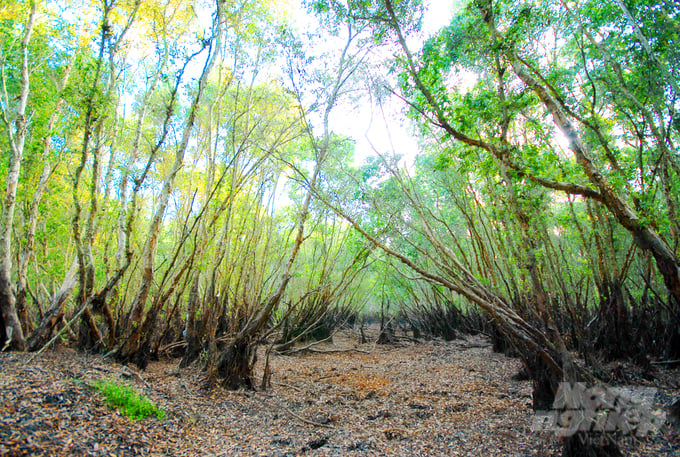
The 7,313-hectare Tram Chim National Park is a biodiversity conservation site, and it protects Dong Thap Muoi wetland's culture and history. Photo: Hoang Vu.
Tram Chim National Park, stretching across 5 communes of Tam Nong district, Dong Thap province, has a total area of 7,313 hectares. The park is a biodiversity conservation site that also helps to preserve the culture and history of Dong Thap Muoi wetland.
The weather in the Southern regions of Vietnam changes drastically during April with the intense heat and rain. Many people visit Tram Chim National Park to immerse themselves in nature, breathe in the fresh air, enjoy the coolness of the park and the beauty of the animals.
Mr. Tran Hao Hiep, Director of the Center for Conservation and International Cooperation of Tram Chim National Park, said that Tram Chim is recognized as a Ramsar site, a wetland of international importance. The park houses over 130 different species of vegetation, 231 species of water birds, with many precious species such as: red-crowned crane, white-winged goose, great cormorant, greater adjutant, etc.
In terms of aquatic species, there are 130 species of freshwater fish including species with high economic value such as snakehead, yellow catfish, forest snakehead, featherback fish, etc. Additionally, there are 29 species of amphibians and reptiles, many of which are endemic to freshwater areas of the Mekong Delta.
“Possessing high biodiversity, Tram Chim National Park helps to preserve the culture, history, and natural landscapes of the Dong Thap Muoi region. Tram Chim National Park is an ideal eco-tourism attraction, with the alluring green color of the immense acacia forest," said Mr. Hoa.
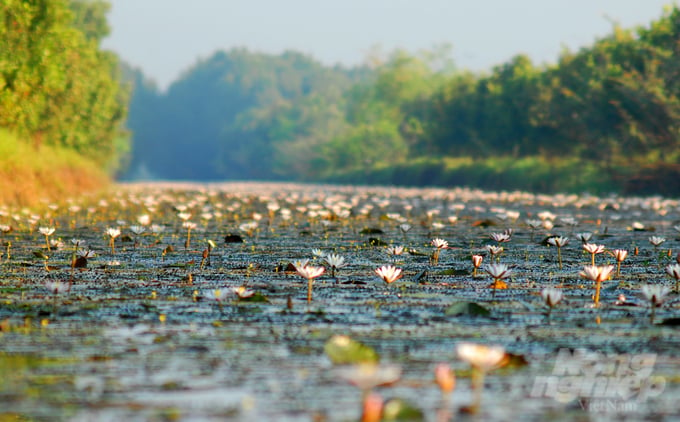
Tram Chim National Park was recognized as a Ramsar site in 2012, a wetland of international importance. Photo: Hoang Vu.
Mr. Nguyen Hoang Minh Hai is the Head of Research and International Cooperation Department of the Conservation and International Cooperation Center (Tram Chim National Park). Following his footsteps in the vast forest, we got to hear more about the biodiversity level of Tram Chim.
According to Mr. Hai, there are two plant species endemic to Tram Chim with high conservation value. They are brownbeard rice (heavenly rice) and the spikesedge community. The brownbeard rice plant creates a food chain for animals during the flood season. Conversely, the spikesedge is useful in the non-dry season.
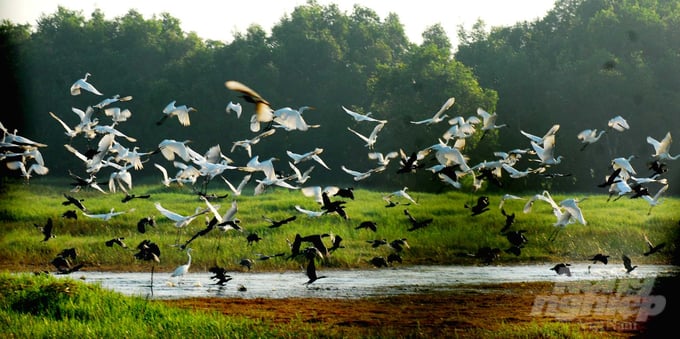
Tram Chim National Park has more than 230 species of water birds, including rare species such as: red-crowned crane, white-winged goose, great cormorant, greater adjutant, etc. Photo: Hoang Vu
The brownbeard rice (Oryza rufipogon) in Tram Chim National Park is an indigenous rice variety that is highly adaptable to the rapidly emerging water season in the Dong Thap Muoi region and it is unaffected by pests. This rice variety can grow by 10 to 20 centimeters per day to overcome the rising water level. The stems can grow up to several meters high to float above the water. When many other types of herbaceous plants are submerged, brownbeard rice serves as the main source of food for the birds and other animals that inhabit the park.
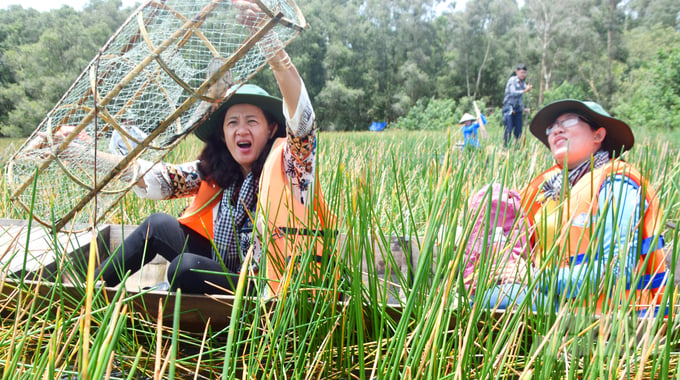
Spikesedge communities grow mainly in the wetlands. When the water dries up, they will produce numerous underground tubers, serving as the main food source for many animals get through the harsh dry season. Photo: Hoang Vu.
On the other hand, spikesedge communities only grow when the climate is most severe in the dry season. During the hot weather, the water dries up rapidly and the alum content rises; many plants expire as a result. However, the spikesedge can still grow and create tubers below the ground. This is the peak season for red-crowned cranes to migrate to Tram Chim National Park.
Mr. Hai gave an explanation, “Red-crowned cranes have omnivorous habits. They eat crabs, fish, and even mice, but spikesedge is their favorite food. Some other animals such as ants, mice, etc. also choose spikesedge as their preferred food source during the harsh dry season".
“Tram Chim National Park was recognized as a Ramsar site by the Secretariat of the Ramsar Convention in May 2012. This is the 4th Ramsar site in Vietnam and the 2,000th Ramsar site worldwide. The Ramsar Convention lists 9 criteria and according to regulations, wetlands only need to meet 1 of these 9 criteria to be considered for recognition. Tram Chim National Park met 6 out of 9 Ramsar criteria," said Mr. Nguyen Van Lam, Director of Tram Chim National Park.
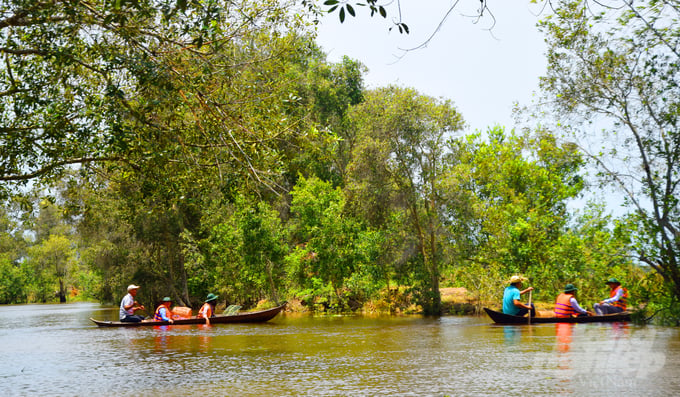
Tourism experience in the Ramsar area of Tram Chim National Park leaves visitors with unforgettable memories. Photo: Hoang Vu.
For many years agricultural and rural tourism activities in Dong Thap have been developed in association with new rural construction. Exxperience tourism in the Ramsar area of Tram Chim National Park is a prime example of this associated development. Tourists can sit and watch flocks of birds flying back to their nests and listen to the mating calls of birds during sunset. They can also welcome the morning dawn in a rustic house while enjoying a lotus-marinated tea, immersing in a vast and quiet space of lotus and rice .
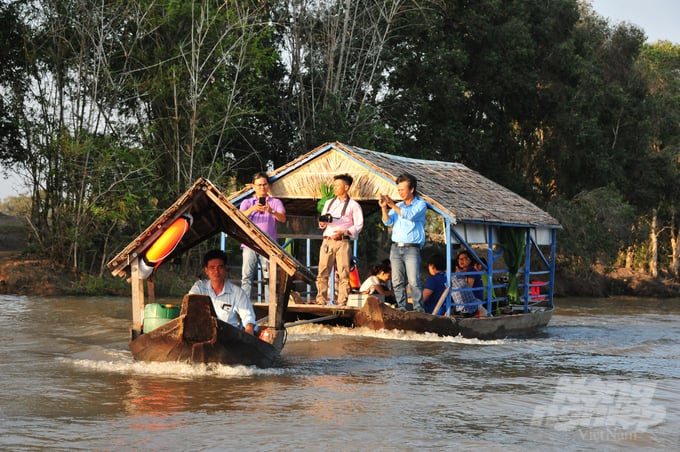
Approximately 100,000 visitors come to Tram Chim National Park every year to explore, learn, and conduct research. Photo: Hoang Vu.
Tram Chim National Park is receiving investment support from the Asia-Pacific Network for Sustainable Forest Management and Rehabilitation (APFNet), the World Wide Fund for Nature (WWF), along with many other organizations. Mr. Nguyen Hoang Minh Hai said that international organizations have funded the park's scientific research activities as well as the development of livelihood models for people living around the park's buffer zone.

"Thap Muoi has the most beautiful lotus flower" is a famous verse deeply imprinted in the mind of many people. The beauty of Tram Chim further enhances this notion. Photo: Hoang Vu.
The model of benefit sharing and rational use of natural resources from the forest has been effectively implemented in the national park. Accordingly, the park has researched and selected species that are able to recover and regenerate quickly for exploitation. On the other hand, the park also focuses on zoning management and exploitation in a reasonable manner.
According to Mr. Hai, people living around the buffer zone are allowed to exploit white fish during the flood season from August to December every year. People traveling in and out of the fishing area must be controlled, and their fishing equipment is monitored carefully. Fishermen can only enter the forest to fish from 6 A.M to 6 P.M daily. Destructive fishing methods are strictly forbidden. In addition to aquatic species, people can also harvest various types of grass as materials for handicrafts knitting.
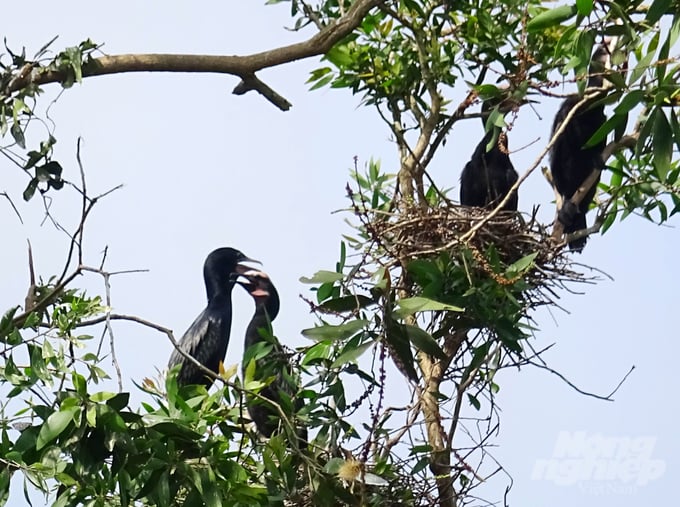
According to regulations, wetlands only need to meet 1 out of 9 Ramsar criteria to be considered for recognition. Tram Chim National Park met 6 out of 9 criteria for Ramsar sites. Photo: Hoang Vu.
Local people are trained in skills and supported to build livelihood models such as combining rice cultivation with fish farming, lotus cultivation with fish farming in the flood season. The locals are supported with bee hives to raise honey bees in the buffer zone, or knit handicraft products from water hyacinth.
The local authorities also offer support in environmental protection activities, underground water well drilling, and water purifier installation. This helps improve people's income, quality of life, and reduce exploitation pressure on forests.
Dong Thap province recently implemented a Project on the Conservation and Development of Cranes in Tram Chim National Park. The project will be carried out during a ten-year period, from 2022 to 2032. The International Crane Organization under the Zoological Park Organization of Thailand (ZPO) signed an agreement to transfer the red-crowned crane in captivity from Thailand to Vietnam. According to the agreement, ZPO will transfer an average of 5 cranes to Vietnam every year.
Dong Thap People's Committee supervises the administration, financial provision and management of Tram Chim National Park in the restoration of the red-crowned cranes. Various organizations will support staff training, captivity development, release and monitoring, and management of crane habitat in the core and buffer zones of Tram Chim National Park. The province aims to create a large population of red-crowned cranes as well as attract wild cranes to Tram Chim National Park.
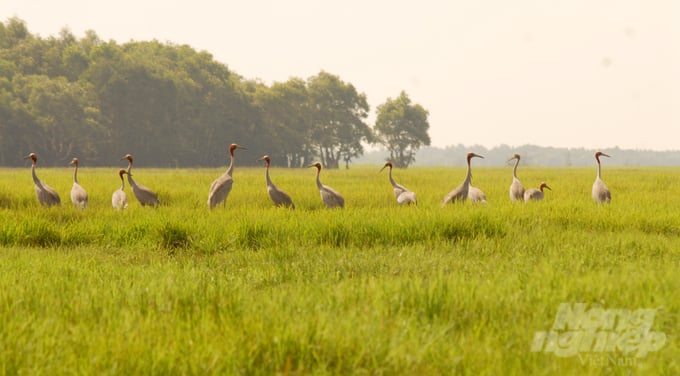
The Red-crowned Crane Conservation and Development Project is implemented by Dong Thap Province, with the hope of creating a large population of cranes as well as attracting wild cranes to Tram Chim National Park. Photo: Hoang Vu.
Dong Thap's agricultural sector has implemented an organic rice production model on an area of 1,138 hectares, located in Phu Duc and Tan Cong Sinh communes, in order to create a clean habitat for the cranes. Moreover, the province designates area A4 of Tram Chim National Park as a free-range crane area.
Mr. Le Quoc Phong, Secretary of the Dong Thap Provincial Party Committee, urged relevant units to complete the approval dossier, focus on renovating area A4. The breeding area and the free-range area must provide the cranes with the best conditions to grow.
"As a Ramsar site, the National Park has many advantages: it will receive more investment from the Government and international organizations, and it will be more popular to tourists. Tram Chim National Park welcomed an average of 5 to 10 thousand visitors annually in the past. However, as a Ramsar site, the number of visitors per year has climbed to 60,000–70,000, with a peak of 100,000", said Park Director Nguyen Van Lam.
Translated by Nguyen Hai Long
/2025/05/25/4127-3-073637_820.jpg)
(VAN) Thanks to the promotion from an FAO-implemented project, vegetable production in greenhouses in Moc Chau has seen strong development, from 1.5 hectares in 2021 to nearly 50 hectares in 2024.

(VAN) FAO has recently supported USD 140,000 to implement the project 'Risk mitigation human-animal interface risks through disease control initiatives in pig farming.'

(VAN) The People's Committee of Tra Vinh province has approved an adjustment to the investment policy for the Green Hydrogen Plant project, increasing its area to approximately 52.76 hectares.
![Reducing emissions from rice fields: [2] Farmers’ commitment to the soil](https://t.ex-cdn.com/nongnghiepmoitruong.vn/608w/files/news/2025/05/05/dsc08881jpg-nongnghiep-140632.jpg)
(VAN) Clean rice cultivation model in Thuong Tan commune, Bac Tan Uyen district, is assisting local residents in achieving sustainable agriculture by substantially reducing costs, increasing productivity, and protecting the environment.

(VAN) At the conference to disseminate Resolution No. 68, AgriS introduced its digital agricultural ecosystem and reaffirmed its commitment to accompanying the Government in promoting private sector development and sustainable agriculture.

(VAN) 'Blue Ocean - Blue Foods' initiative is designed to restore marine ecosystems and establish sustainable livelihoods for local communities by cultivating a minimum of 1,000 hectares of cottonii seaweed in the first three years.
/2025/05/21/4642-3-112707_603.jpg)
(VAN) The V-SCOPE project has made direct contributions to three out of six pillars of the Comprehensive Strategic Partnership between Vietnam and Australia.